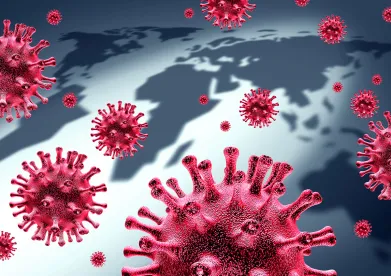The COVID-19 emergency led the Member States of the European Union to adopt appropriate preventive measures aimed at achieving a healthy and safe resumption of work activities and avoiding the spread of the virus at the workplace. This article includes the French, German, Italian and United Kingdom perspective.
France
The gradual end of the lockdown in France started as of 11 May 2020.
Different documents have been published by the French government to assist companies organize the return to work:
-
on 28 April 2020, the French Prime Minister presented to the Parliament the "National plan for the end of the lockdown" (Plan) providing a general framework that may be adapted by each department;
-
on 3 May 2020, the French Labor Ministry published a "National protocol regarding the end of the lockdown for companies to ensure health and safety of the employees" (Protocol), specifying the measures to be applied within companies;
-
on 7 May 2020, the French Prime Minister disclosed a map showing "red" and "green" departments: "red" for departments where the number of contamination cases remains very high and for which strict measures still apply and "green" for the departments with a lower contamination rate for which the resumption to normal life will be less restrictive.
The documents published by the French government, as well as the recommendations available on the sites of the various ministries, encourage a gradual return to work on the company's premises in order to avoid any risk of contamination, but maintaining remote work remains the recommended option.
Consequently, it is essential for companies to assess as soon as possible the necessary arrangements of the works organization for a gradual and safe return to work. It is necessary to establish an operational diagnosis in order to determine:
-
which employees / services are physically needed within the premises of the company,
-
or, on the contrary, which employees should continue to work remotely in light of their personal situations (e.g: presence of a sick person in the home, children who do not return to school, the constraint of public transport, etc.).
Return to work directly affects the employer's safety and security obligation towards employees. The company and its legal representatives are criminally liable for this obligation. Therefore, if an employer fails to comply with its obligation to provide sufficient and appropriate protective measures for employees to carry out their duties in a safe manner (i.e., soap, hydro-alcoholic gels, masks, minimum safety distance, barriers between employees etc.) , employees could trigger the company's liability or exercise their right of withdrawal (droit de retrait).
In the Protocol, the French Labor Ministry reiterates the main rules of risk prevention:
-
eliminate or reduce the contamination risk, in particular by promoting remote work whenever possible;
-
give priority to collective prevention measures (i.e., shift rotation, change in break times, circulation organisation, protective glazing, spacing of workstations, disinfectant cleaning if the premises have been used in the last 5 days, etc.);
-
alternatively, provide for individual prevention measures (masks, soap, hydro-alcoholic gel, etc.).
-
update the document for the assessment of risks ("Document Unique d'Évalution des Risques"), act in collaboration with the employees' representative institution ("CSE") and inform the employees.
From a practical standpoint, barrier measures are essential, and additional clarifications were provided by the Government:
-
use of gloves is not recommended,
-
a space of 4 square meters per person in the same space must be insured; failing this, the wearing of "general public" masks must be mandatory;
-
occupancy plans must be drawn up, and companies are being invited to provide information on peak periods via digital tools (applications, website, mailing, etc.)
In addition, according to the Protocol (which, however, is a government recommendation and not a legal mandate), screening tests at the entrance to the company's premises are not authorised (several groups had announced that they would provide screening tests for their employees). The Protocol also states that systematic monitoring of employee temperatures is not recommended. However, if the employer wishes to set up a temperature control at the entrance of the company, it must (i) post an information note for the employees (ii) provide employees with sufficient guarantees (i.e., prior information in particular regarding the maximum temperature allowed in the premises and the consequences of a positive control, compliance with the General Data Protection Regulation regarding personal information, etc.).
For implementation of the new work organization and safety measures within the company, employers should consider involving the CSE, the labor doctor and the employees. In particular, the labor doctor and the CSE may also assist the employer in establishing specific procedures for the care of symptomatic employees in order to, (i) train the labor health services, (ii) isolate the symptomatic employee, (iii) identify the persons in contact with the employee, and (iv) organise the employee's return to home or the takeover by emergency services.
Germany
The German Federal Ministry of Labor issued specific Covid-19 workplace health and safety standards employers should take into account when employees return to work (official English version available here. While the standards are not directly applicable law, they need to be considered when determining "necessary measures" required for the protection of employees under applicable health and safety laws. Non-compliance with the standards currently would not immediately result in fines. However, non-compliance could result in employers being held liable, especially towards employees based on a breach of their general duty of care.
The standards include preventive measures going beyond common workplace health and safety measures. As a general principle, employers shall sufficiently inform employees with regard to infection prevention as well as other health and safety measures at the workplace. Further, they shall ensure that employees comply with general hygienic precautions. Furthermore, the standards include various specific technical, organizational and personnel prevention measures such as:
-
Ensuring sufficient distancing (at least 1.5 meters) and implementing alternative safety measures (such as transparent walls) where required. Where distancing is not possible, protective facial masks should be provided and used.
-
Extending hygienic measures (such as provision of soap and towel dispensers, frequent cleaning of sanitary rooms and common areas, including doorknobs and handrails).
-
Office work to be carried out from home where possible. Business travel and meetings to be reduced to a minimum and replaced by technical alternatives where possible.
-
Limitation of access to the business premises by externals and documentation of any such access where possible.
-
Use of working materials (including vehicles) on a personalized basis only where possible. Regular cleaning, especially prior to any required use of materials by other employees.
-
Reduction of occupancy density at work and common areas by implementing staggered work and break times, shift work, etc. In the case of shift work, the employees working at the same time should stay the same where possible.
The employer should further implement internal rules for a quick response to suspected infections. Where symptoms arise, a contactless temperature scan should be provided. Employees with symptoms (fever, cough, shortness of breath) should be requested to stay at home up until clarification of the suspicion by a doctor. The employer should also have a pandemic plan covering the scenario of a confirmed infection and information of persons that were in contact with the infected person (e.g. employees and/or customers).
If a works council exists, mandatory co-determination rights may be triggered when implementing specific measures. Further, employers should involve the occupational safety specialist and the company doctor or set up a pandemic management team.
Finally, strict data privacy laws in Germany need to be considered. Asking employees specific health related questions or administering broad obligatory health checks such as temperature scanning, saliva tests, or similar will generally not be possible due to data privacy laws. However, employers should ask employees to immediately disclose Covid-19 related symptoms as well as contacts with other potentially infected persons in order to react to any such disclosures.
Italy
In order to manage the return to work in during the Covid-19 emergency, Italian companies are required to adopt a set of precautionary measures by (i) a Protocol executed by and between the trade unions, the Government and the associations of employers (the Protocol), recently amended on 24 April 2020, and by (ii) a Note issued the same date by the Italian Institute for Insurance Against Accidents Occurred At Work (the "Note" and along with the Protocol jointly referred to as the "Regulations").
The Regulations require employers to take the following steps:
-
Involve the Company Doctor in the evaluation of all the necessary measures to be adopted, including medical check-ups of employees.
-
Update the Risk Assessment Document (Documento Valutazione Risci - the RAD) with the assistance of the Company Doctor, so that each and any risk connected with biological agents is duly detected.
-
Properly inform and instruct employees about the new biologic agent-related risk, the hygienic-sanitary behaviours to be followed and the official communications issued by the Competent Public Bodies.
-
Adopt new individual protection devices, such as single-use gloves, certified masks, and hand-washing hydro-alcoholic measures.
-
Ensure both the day-to-day cleaning and the periodical sanitization of the premises, rooms, workplaces, common areas and working tools. Where possible, a distance of at least 1 meter between individuals shall also be guaranteed.
-
Adopt anti-infection security protocols and draft a specific emergency plan in case of risk of dissemination of the virus. An ad hoc committee should also be established along with works councils and the safety representative for employees, which committee should periodically meet to evaluate whether the health and safety measures adopted from time to time are fit for their intended purposes.
-
Use temperature scanners to measure the employees' body temperature, in compliance with the privacy legislation currently in force. If the body temperature exceeds 37.5°, the employer should prevent the employee from entering the workplace. Clinical tests to be conducted on employees seem viable too. However, they can be conducted and co-ordinated only by the Company Doctor under the terms and conditions provided by the Italian Labour law and Data Protection law.
-
Implement an ad hoc reorganisation plan in agreement with the works council. In this regard, the Employer should:(i) redefine all the production levels; (ii) ensure a rotation plan of the employees in order to limit physical contacts as much as possible and create independent and separate groups; (iii) prioritize the use of smart working for all working activities which can be carried out remotely and grant the employees holidays and permits to leave; (iv) re-organize workspaces to ensure the minimum social distance between employees, in accordance with the business requirements; (v) promote and sponsor the use of private vehicles or shuttles, in order to reduce the risk that the employees are infected when commuting through public transport; (vii) suspend and cancel all national and international business travels and missions; and (vii) limit as much as possible the employees' movements within the company's premises and limit their access into common spaces.
-
Identify specific procedures for entrance, transit and exit of suppliers in order to limit their access into the premises and contacts with the company's personnel. In addition, where employees of third-party companies/contractors operate in the same productive unit (e.g. maintenance technicians, suppliers, cleaners or security guards), the company shall provide its contractors/third-party companies with its own security guidelines and make sure that the third-party companies'/contractors' employees fully comply therewith.
-
In the event of personnel's flu-like symptoms, the employer shall adopt specific measures in order to isolate the employee and all the other employees working in the company's premises. Specifically, if an employee is tested positive to COVID-19, the company (a) shall promptly inform the health authorities, (b) shall sanitize the company's premises and (c) may ask all the employees who had "close contacts" with the infected one to leave the company's premises. An employee tested positive to COVID-19 may be enabled to return to work only upon proper certification issued by the competent health authority.
As a general rule, the Employer is primarily responsible for health and safety in the workplace. Should the employer fail to adopt all the safety measures provided for by law and the Regulations, it may be held liable both under a criminal and an administrative perspective and may be sued by such employees who became infected at work for compensation for damages. In addition, business and operations may be suspended until the proper health and safety conditions are duly restored.
United Kingdom
On 11 May 2020, the UK Government published guidance for employers to help them manage employees returning to the workplace and for workplaces to operate safely.
The guidance is comprised of 8 separate guidance notes. Each note covers a different workplace setting which is allowed to be open, subject to certain conditions. These workplace settings are:
-
Construction and other outdoor work;
-
Factories, plants and warehouses;
-
Labs and research facilities;
-
Offices and contact centres;
-
Other people's homes;
-
Restaurants offering takeaway or delivery;
-
Shops and branches; and
-
Vehicles.
Specific guidance has been published for each of the above workplaces but, in general, the guidance focuses on five key principles:
-
Work from home, if you can: Employers should take reasonable steps to help employees work from home where possible. However, employees who cannot work from home and whose workplace has not been told to close should go to work. Employers should consider who is essential to be on-site and plan for the minimum number of people needed to operate their business safely and effectively.
-
Carry out a COVID-19 risk assessment: Employers have a duty to consult with their workers or trade unions to establish what safety guidelines to put in place. Where employees are returning to the workplace, the UK Government expect all businesses with over 50 employees to publish the results of their risk assessment on their website.
-
Maintain two metres social distancing, wherever possible: Employers should re-design workspaces to maintain 2m distances between people. Possible solutions include staggering start times, creating one way walk-throughs, opening more entrances and exits, or changing seating layouts in break rooms, canteens and common areas.
-
Where people cannot be two metres apart, employers must manage transmission risk: Employers should look into putting barriers in shared spaces, creating workplace shift patterns or fixed teams minimising the number of people in contact with one another, or ensuring colleagues face away from each other.
-
Reinforcing cleaning processes: Workplaces should be cleaned more frequently, paying close attention to high-contact objects like door handles and keyboards. Employers should provide handwashing facilities or hand sanitisers at entry and exit points.
Each workplace specific guidance note covers the following areas in more detail:
-
Risk - including risk management and risk assessments;
-
Who should go to work - including people at higher-risk and equality in the workplace;
-
Social-distancing - including travel to and from work, workstations, meetings and common areas;
-
Managing customers, visitors and contractors - including explaining available guidance;
-
Cleaning the workplace - including before reopening, cleaning and personal hygiene;
-
Personal Protective Equipment (PPE) - including face coverings;
-
Workforce management - including shift patterns, travel, communication and training; and
-
Inbound and outbound goods - including prevention of surface transmission.
At the heart of the UK Government's guidance is the safety of employees and the need to control the spread of COVID-19. The UK Government has acknowledged that "unless people feel safe, employees won't return, customers will stay away and the restart will falter, harming livelihoods and public services".
The key theme that emerges from the guidance is that employers bear a legal responsibility to protect their workers and others from risk to their health and safety. Employers are encouraged to have open and proactive dialogue with their workforce in order to agree to safe return to work policies and procedures.
The UK Government expects this guidance to evolve over time and has committed to setting up taskforces to work with sectors currently closed (such as bars and restaurants) to develop safe ways for them to open at the earliest point at which it is safe to do so. We are closely monitoring the situation for any developments.







 />i
/>i

